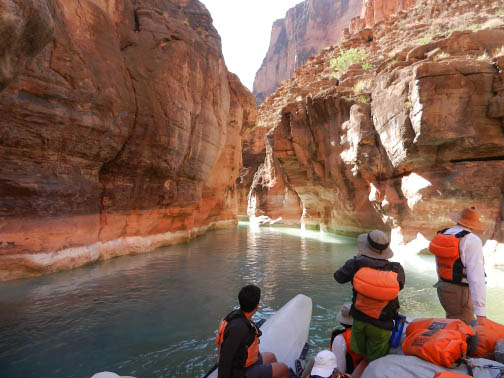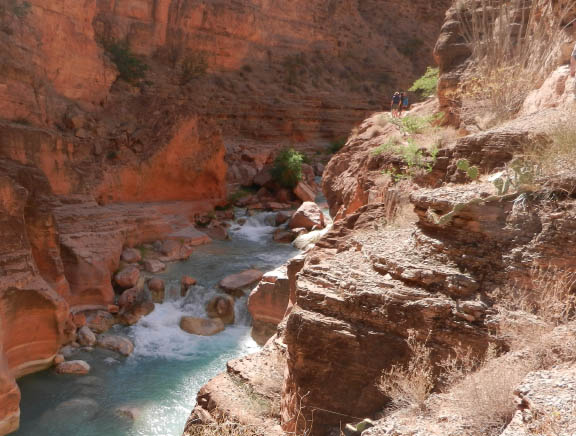In the last few months, a couple of things have occurred that have made me more conscious about where I am on my life journey. One was my 50th college reunion, an opportunity for us old grads to gather, spin old stories of “Remember when. . .” and be celebrated on the golden anniversary of our graduation. To further entice us, organizers planned a golf outing. I didn’t join them for either occasion but the reunion made me realize that at 72, to use an analogy that my golfing classmates would appreciate, I’m closer to the 19th hole than I’ve ever been.
That would be a commonplace thought of mortality anyone my age might entertain, except for something else that happened at about the same time.

Havasu Creek entering the Colorado River. Courtesy Jim Parsons.
On a rafting trip through the Grand Canyon, a group of us took a hike up Havasu Canyon to see the famous blue-green waters of Havasu Creek and Falls. Walking to the falls along a rock ledge in the canyon, I slipped on a loose patch of sand and gravel and tumbled down the slope to the brink of a sheer drop. I stopped just short of the edge, but close enough to glimpse a cluster of boulders below. I can still see them when I run that memory clip over and over in my mind.
I don’t remember hitting my head and opening up a bloody gash. I don’t remember how I hurt my ribs so that they were sore for weeks after. But when I peered over the edge at the rocks below, I was fully alert.
As I struggled to get to my feet, one of our group, a cardiologist named Dave, scrambled down the slope toward me and shouted, “Don’t move! Don’t move!” I thought he was worried that I was going to lose my balance, but he was more concerned about a possible concussion. “Your head is bleeding! Sit down!” he said. I noticed a trickle of blood coursing down my arm. He had me count backwards from 10. He looked into my eyes. “This isn’t really my line of work but I don’t think you’re concussed,” he said. Our guide Lars joined him a few minutes later with the first aid kit. He and Dave washed the blood from my head wound and inspected it. “You’ll have a big bump but there’s no skull showing,” Dave said. “That’s good.”
I thought, “There’s nothing good about this.”

Hiking in Havasu Canyon. Courtesy Jim Parsons.
A little later, a cold compress covering the wound, I walked back up to the trail. Other hikers paused on their way to the falls. “I’m okay,” I said about a dozen times. “Sorry to hold you up.” “How did you stop yourself from going over?” they asked, when they found out what had happened. I shrugged. “I don’t know.” I looked down at the rim where I had stopped and noticed a rock that sat right at the edge. “I think it must have been that rock,” I said.
It was an oval-shaped stone, about the size and color of a large loaf of Italian bread. It was rounded as if it had lain in a bed of flowing water for thousands of years. I can almost feel it as I visualize it—dusty and dry, light-colored but speckled with darker material. It was just a speed bump, really, a solitary rock at the edge of the cliff, but it stopped me cold. I had to roll down the slope at a precise point and angle to hit that rock. If I had taken a step or two further along the trail and then fallen, I might well have gone over.
Surely a 10-foot drop onto a bunch of boulders would have had ruinous consequences on my body, or worse. The way I began looking at it, the rock had saved my life. Because of it I was able to walk away from the accident with bruised ribs, yes, a bad cut on the noggin, certainly, but also with my life, a future and a tale to tell. But what was that tale? I walked out along the canyon trail that afternoon, and for many days afterward, told a story about how close I had come to dying. And I would have died, too, had it not been for that rock.
After a few weeks I began to be less confident in my story. Would I have actually died? I never got a good look at what lay over the lip of that canyon wall, although I distinctly remember seeing large boulders. Maybe there was a small, sandy beach below, just between the boulders. And maybe a large bush grew on the sandy beach that would have softened my fall. Maybe an angel would have caught me in mid-air. There were a lot of maybes in the story.
It was frustrating. I couldn’t tell a story until I understood what might have happened to me in Havasu Canyon. I telephoned my friend Bruce who had been walking behind me that day. Had he seen what lay below? “No,” he said. “I never looked. All I saw was you bleeding.”
I e-mailed Lars, the guide who had administered First Aid while I sat on the slope. “If I had gone over, what would have happened to me?” I asked.
“There were large boulders beneath you that would have stopped you before you got to the cataracts below,” he wrote. “I’m relieved that you were able to control your descent as more speed might have caused you to break something.”
Break what? My skull, back, neck, the pinkie of my left hand?
His reply didn’t really answer my question. “You would have died!” That’s the clarity I wanted, the clarity I didn’t have. When I started thinking about e-mailing other rafters with the same questions I began to wonder whether I had hit my head a little too hard. Did it really matter whether I would have been killed or just badly messed up if I fell over the canyon edge? Who would be able to tell me that definitively?
The only thing I knew for sure was that I slipped and fell, bruised some ribs, gave my head a bloody whack and got a scare. I suffered a minor fall and avoided a major one.
It began to sound like something very ordinary had happened—a close call, say, something that happens any number of times in a lifetime. Like the innumerable times I’ve edged my car away from the curb outside my house without looking in the rear view mirror and stopped just short of hitting a passing car. Or the time, as a boy, I swung a softball bat that flew out of my hand in lazy helicopter circles toward a family of picnickers and just grazed the head of a man grilling burgers. Close calls.
Yet my fall at Havasu felt different from a close call. Many times since then, I’ve mentally retraced my steps along the canyon, felt the ground give way beneath me once more, followed my body as it rolled down the slope and then, inexplicably, stopped. The incident felt steeped in meanings. Life is a gift. Life is fragile. Accident and chance shape a life as much as intention, so much so that my continued life seemed to depend on the presence of a single stone.
One or two of my friends invoked a deity to explain my good fortune–God put that rock there because He had more work for me to do. In Providential history there are no accidents; the universe is ruled by God’s mysterious purposes. But after traveling for the better part of a week through one of the greatest geological lessons on earth, the Providential explanation didn’t sound likely. I had seen a mile-high stack of rocks formed by incredible forces through long, geological ages, a billion years of Grand Canyon faulting and lava flows. And then I saw my little rock, massaged and rounded by flowing water during more millennia, raised up by a mighty flood at some point and deposited on the very lip of a canyon wall.
Random natural forces put that stone there and there it sat until it collided with my own life’s orbit.
Beyond that the lessons were few. Would my accident prevent me from hiking again in high country? No. Would I be more cautious as a result of my fall? A lack of caution didn’t cause the accident, so extra caution wouldn’t necessarily prevent another. What I increasingly began to focus on was my reaction at the edge of the cliff as I struggled to get up and remove myself from danger. The heart of the experience, it seemed to me, lay in my will to get back on my feet, my will to live. That was the story that I could tell. It was a simple story, but it was also the truest one.
Epilogue
A month and a half after returning from my trip, I fell off the second-story roof of my house while clearing a storm’s harvest of dead branches and twigs. It happened just about as fast as you can snap your finger. I hadn’t realized the shingles were slick from the rain, and I slipped. There was no rock to stop me this time. I slid down the slope of the roof toward the gutters and into thin air—just a six-foot drop to the first-floor roof below. I landed on my feet and then on my butt. I stood up and looked myself over. No blood. No bruises. No one running to see if I was okay. No need for a doctor.
I climbed down the ladder very carefully. When I got to the deck I was shaking. Do I really need to be cleaning my roof, I wondered. Maybe that’s a job someone younger could do. It seemed like a very mature decision, and I felt good about it for a couple of hours. But by then the roof had dried in the sunlight so I climbed up and finished the job.